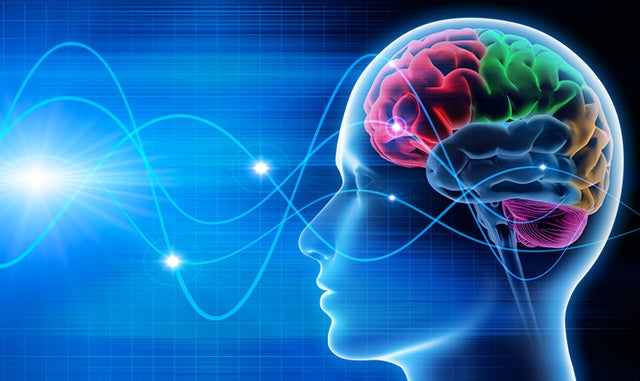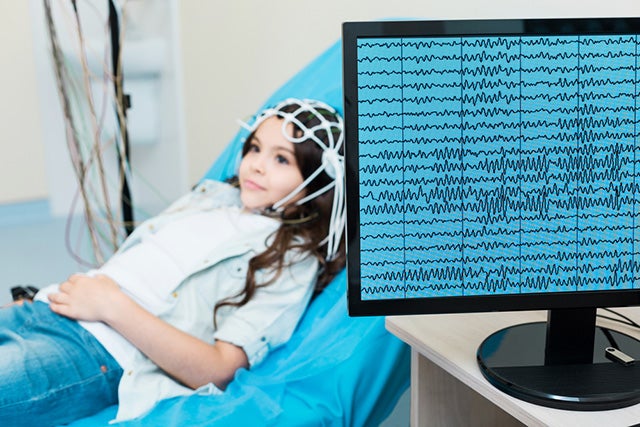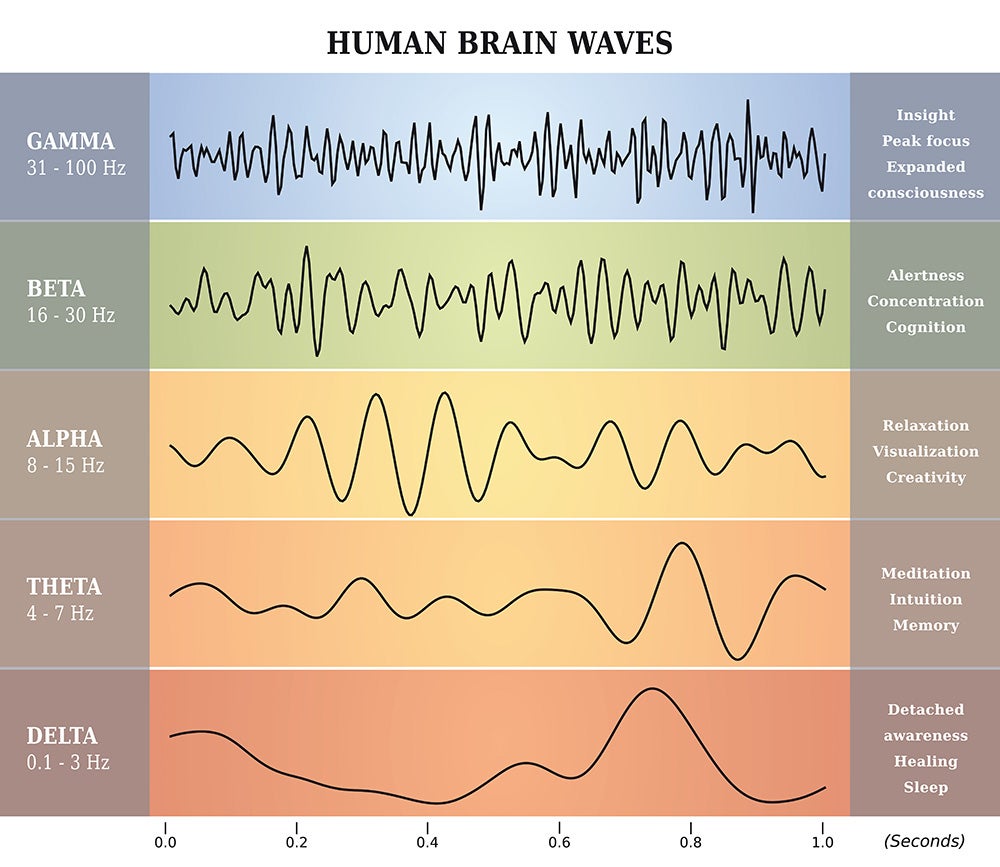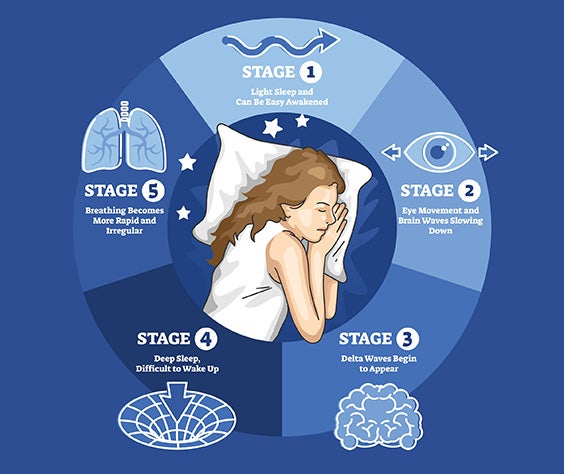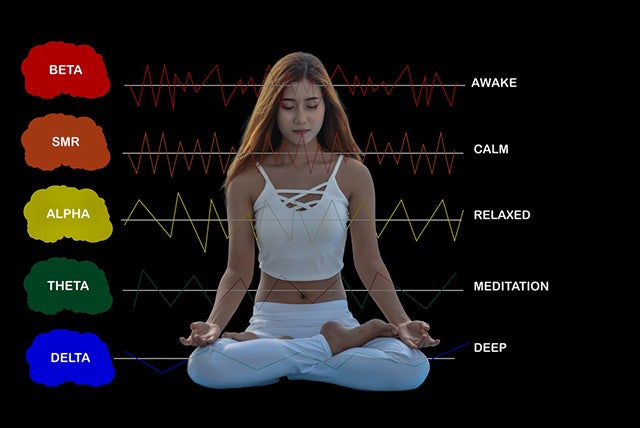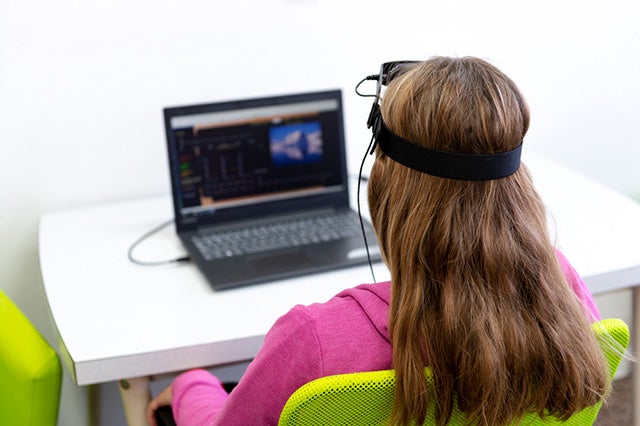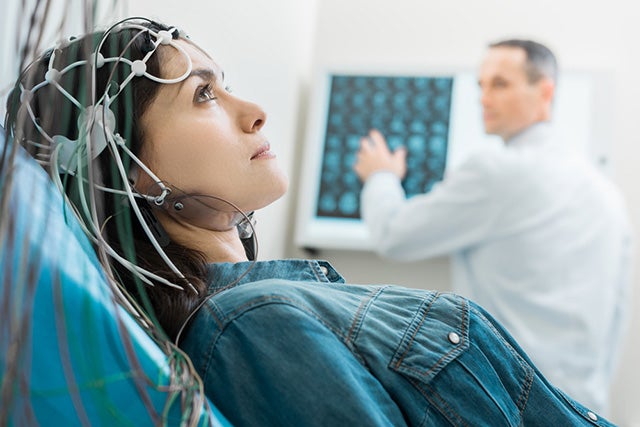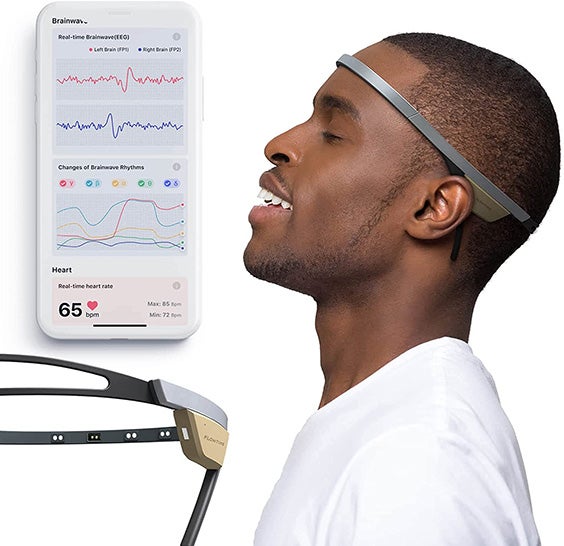Did you know that you can influence your brain to help you study or sleep better? Discovered by Hans Berger in 1875, brain waves have been a study topic for decades.
As one of the most fascinating organs in the body, there is still much-unexplored territory, but scientists may have figured out ways to train your brain for certain activities. How does this work?
What Is Brain Wave Manipulation?
The electrical impulses in the brain are known as brain waves. Neurons in our brains communicate with one another, allowing for the expression of an individual’s behavior, thoughts, and feelings.
Electrical pulses that are synchronized and generated by large numbers of neurons communicating with one another are the source of all brain waves. Our brain waves occur at various frequencies. Some of them move quickly, while others move more slowly.
Delta, theta, alpha, beta, and gamma are the traditional designations given to the many bands that can be found on an EEG. Cycles per second, often known as hertz (Hz), is the unit of measurement for them.
There are billions of different types of cells that make up the brain, and one of those cell types is called a neuron. Electroencephalography, also known as EEG, is a method that uses scalp-attaches sensors to record your brain waves.
Neurons are constantly communicating with one another, and the electrical activity that results from this communication can be detected using this method. When someone is giving their complete concentration and attention to something, the shape of the wave shifts from what it is when it is at rest.
The concept of brain wave manipulation is that you alter or nudge these waves in one direction or another.
How Does Brain Wave Manipulation Work?
Clinicians have developed non-invasive methods not only for measuring but also for manipulating patients’ brain waves.
Changing brain states that aren’t desirable is the goal of neuropsychology therapy, which employs techniques such as LENS, transcranial magnetic stimulation, and learning-based neurofeedback, among others.
People suffering from a wide variety of conditions, such as depression, anxiety, chronic pain, or PTSD may find relief via the use of these strategies.
The Monroe Institute, which Robert Monroe established, was a pioneer in the development of an auditory approach for detecting alternative brain waves by utilizing the Binaural Beat Technology.
According to Monroe and the pupils he taught, we can learn to enter higher levels of consciousness, exit our bodies, and engage in infinite astral travel if we use binaural beats under controlled conditions and listen to them in a specific order. This notion is fairly radical, yet the therapeutic ability of brain entrainment employing binaural technology is not.
Types of Brain Waves
As mentioned earlier, brain waves are measured in hertz and the number of cycles per second has allowed science to classify these into five categories.
— Delta Brain Waves
Delta frequencies, which range from 0.1 to 3.5 hertz, are the slowest and lowest frequencies ever measured in human brainwaves. Sleep that is restorative, lacks dreams, and sleep that does not involve rapid eye movement are all related to delta waves.
Even while they are awake, infants up to one year old have a predominately delta frequency brain wave pattern, but healthy adults only experience delta waves during the deepest stages of sleep.
The activity of delta waves then gradually decreases with time, beginning with a dip of 25 percent during slow-wave sleep when a person is an adolescent and continuing with a large overall drop in their 40s.
If your delta activity levels are low, it’s possible that you won’t get the kind of deep, rejuvenating sleep that both your brain and your body require in order to heal, retain information, and function at full capacity when you’re awake.
— Theta Brain Waves
Although it is still slow, theta activity is not even close to being as slow as delta waves. Theta brainwaves occur most frequently while you are either asleep or in that state where you are suspended between wakefulness and sleep Their frequency ranges from roughly 3.5 to about 8 Hz.
Theta brain waves are in strict correlation with REM sleep and dreams but you can also notice them during meditation. They seem to be present when a person is in a creative mind state. Intuition, memory, and learning are when theta brain waves really kick in.
— Alpha Brain Waves
Alpha waves have a frequency range of 9 to 12 Hz, with most people seeing a peak around 10 Hz. The presence of healthy alpha activity is linked to feeling calm and relaxed, which is not the optimal mental state for solving difficult problems.
Imagine that you are in a state of wakeful rest, where you are able to think but are not really focused on anything in particular.
There is a correlation between enhanced alpha brainwave activity and greater creative output, creative problem solving, and a reduction in anxious and melancholy thinking.
— Beta Brain Waves
Beta is the primary state of the awake brain for most adults in the modern world, especially when you are actively involved in something, such as your work, listening, trying to solve a problem or processing information. You can choose to be relaxed while in beta, but you will still be attentive and vigilant.
Although beta brainwaves range from 13 to roughly 40 Hz, greater frequencies have been shown to cause anxiety in some individuals.
Low beta waves have a frequency range of approximately 13 to 15 Hz and can be detected when someone is thinking.
If your beta waves are between 15 and 22 hertz, it indicates that you are most likely engaged in a mental task or otherwise concentrating on something.
When you are more excited, agitated, or apprehensive, you experience high beta waves, which have a frequency range of approximately 22-38 Hz.
— Gamma Brain Waves
Gamma brain waves represent the peak of your brain wave intensity. Whenever you are intensely focused, your brain waves measure between 30 and 44 Hz. Science says this is the only frequency located in all brain parts and activates when you have to process information using multiple brain parts.
There is a correlation between having low gamma activity and having reduced cognitive processing, restricted memory, and learning issues. Researchers believe that increasing the number of gamma brainwaves in the brain through training could lead to an improvement in intellect, but further proof is needed.
How Can Brain Wave Manipulation Improve Sleep?
Sleep is for rest and restoration, but the brain is actually very active even as you’re sleeping. There are different sleep stages throughout the night and your brain waves are altered as you go through them.
You might want to read this: The Stages of Sleep
— Sleep Stages & Brain Waves
The transition from the relaxed state into sleep ushers in the first stage, which is characterized by the appearance of theta waves instead of alpha waves. Light sleep is the sleep that is readily disrupted.
The second stage of sleep is characterized by a gradual slowing of brain waves as alpha activity comes to a complete halt and theta waves take over as the predominant type.
Stages 3 and 4 are highly comparable to one another due to the fact that both involve a state of profound sleep. As delta waves arise, there is a slowing down of overall brain activity. These are the stages of sleep that are associated with sleepwalking as well as nightmares.
When a person is in the rapid eye movement (REM) stage of sleep, the muscles in their bodies temporarily become paralyzed, and their eyes move swiftly. Additionally, dreaming takes place throughout this stage. In this stage of sleep, the pattern of brain waves is comparable to what it was in stages 1 and 2, despite the fact that the sleeper is in a more profound state of sleep.
— Sleep & Binaural Beats
The activity of brainwaves while sleeping is significantly different from the activity of brainwaves while waking. The only exception is the REM sleep stage, as the brain is just as active then as it is when you’re awake.
Theta and delta waves, which have a slower and lower frequency than alpha and beta waves, predominate during non-REM sleep. This is in contrast to alpha and beta waves, which dominate when you are awake and active.
A treatment that slows down the activity of brainwaves and contributes to the production of low-frequency waves is likely to be beneficial for relaxation and sleep.
However, the potential benefits of binaural beats to sleep and relaxation go beyond simply lowering the frequency of brainwaves. A preliminary investigation involving only 19 participants indicated that exposure to binaural beats was connected with changes in the levels of three hormones that are crucial to the quality of sleep and overall health.
— The Role of DHEA
DHEA plays a role similar to that of a master hormone, as it contributes to the production of other hormones in the body on a daily basis. DHEA is essential to the proper functioning of the immune system and the prevention of disease.
DHEA’s ability to inhibit cortisol, a hormone that, in high amounts, promotes alertness and contributes to stress, is one of the most important reasons why it’s important to get enough sleep. The results of the study showed that after employing binaural beats, there was a rise in DHEA levels in 68 percent of the subjects.
— Increasing Melatonin
Melatonin is both an inducer and a regulator of sleep. The evening sees a significant elevation in melatonin levels, and this hormone works to relax both your mind and body, getting you ready for a restful night’s sleep.
After listening to binaural beats, the majority of study participants exhibited increased levels of the hormone melatonin. The whole percentage rose by more than 97 percent on average.
— Lowering Cortisol
A hormone that stimulates alertness and attentiveness, cortisol is known as an arousal hormone. Cortisol levels fluctuate throughout the day as a result of circadian rhythms. Cortisol levels reach their highest point first thing in the morning, just in time for you to begin your active day.
Insomnia and a greater proportion of time spent in lighter stages of sleep, as opposed to deeper stages, are both linked to elevated levels of the stress hormone cortisol. After listening to binaural beats, the researchers observed that 70 percent of the subjects had a lower level of the stress hormone cortisol.
Is Brain Wave Manipulation Harmful?
In spite of the fact that these studies give the impression that brainwave entrainment does, in fact, function, it is essential to be aware of the extremely unlikely but nonetheless conceivable adverse consequences that may be brought on by brainwave entrainment.
Symptoms such as nausea, anxiety, migraines, confusion, convulsions, dizziness, elevated heart rate, and overwhelming visions in one’s mind have been linked to this condition. If you suffer any of these side effects, you should immediately discontinue utilizing the brainwave entrainment method.
Brainwave entrainment can be put to a wide variety of uses, but in order to find what works best for you, you will likely need to try it with a number of different devices and positions. Each individual possesses a unique brain.
Which Brain Waves Are Best for Sleep?
Theta brain waves can be found when a person is sleeping, although they are not present during the most profound stages of sleep. It’s possible that you’ll have one as you’re dozing down to sleep or while you’re hanging around in that light phase of sleep right before you wake up.
They might also be noticed when one is awake, but in a state of mind that is extremely deeply relaxed; this is a state that some people may characterize as being “autopilot.”
On the other hand, if you are awake and experiencing high levels of theta waves, you may have the sensation of being scattered while they are present.
Theorists and researchers agree that theta waves have a significant role in the creation of memories and the processing of information. As researchers gain a better understanding of how they function and how they are connected to various forms of learning, this information may come in handy when deciding the most effective strategy to assist people in learning new things.
Delta waves are the waves that predominate when you are in a state of deep, restorative sleep. Theta waves are produced more frequently during lighter stages of sleep. They take readings in the range between 0.5 and 4 Hz.
You might be interested: 45 Sleep Tips That Will Make You Fall Asleep in 7 Minutes or Less
How Do You Manipulate Brain Waves for a Better Mental State?
Because irregularities in brain activity can play a role in the development of a variety of mental health problems, brain waves have a significant relationship with a person’s mental health.
Anxiety, night terrors or other sleep disturbances, impulsivity, and aggressive behavior are some side effects that can occur when particular brain regions are overstimulated, for instance.
On the other side, low levels of arousal in the brain have been linked to conditions such as chronic pain, depression, and sleeplessness. If a person’s brain rhythms aren’t stable, they have a greater risk of experiencing obsessive compulsions, developing epilepsy, or having panic attacks.
— Scientific Evidence
Recent research in neuroscience has pointed to an association between an excess of gamma waves in the brain and the mental illness known as schizophrenia.
Gamma waves produce hyperactivity in some parts of the brain. Hallucinations and delusions can emerge as a consequence of this hyperactivity when it is excessively elevated, as it frequently is in people who suffer from schizophrenia.
Research on brain waves has also demonstrated that certain people may have a biological predisposition that makes them more susceptible to developing depressive symptoms. These people have a lot of alpha wave activity in the frontal left portions of their brains, which is a sign of good mental health.
Attention deficit hyperactivity disorder is another ailment that is characterized by an abundance of brain waves with lower frequencies. When undergoing neurofeedback therapy, patients suffering from both of these illnesses, along with others, have shown signs of improvement.
— Neurofeedback Therapy
Neurofeedback is a therapy approach used to monitor and change the patterns in our brain waves with the goal of changing behavior for our mental well-being. During these therapy sessions, people are taught how to alter their brain waves.
With the help of EEG readings, the therapist can identify brain wave levels, see when abnormal activity increases and rewards the brain accordingly to make it more productive.
— Wearable Devices
There are a variety of wearables and other gadgets that utilize neurofeedback, which means that you can get really high-tech if you want to. Feedback can be compared to the speedometers on highways, which keep track of how fast you’re traveling and flash warning lights if you go above the posted limit.
This signal not only provides you with information about your behavior but also serves as a warning to modify it, in this case, to slow down. Neurofeedback works in a similar manner to EEG in that it monitors your brain waves and then relays that information to you in order to encourage particular patterns of waves and, by extension, mental states.
These are headbands that can read your brainwaves as you’re performing a task so that you know the activity level in your brain. They translate these waves into frequencies that they can later reproduce.
— Binaural Beats & Music
You can also manipulate your brain waves in accordance with certain external stimuli (in this case, audio cues). During a certain activity, your brain can be trained to synchronize with a certain frequency so that you can improve your performance.
You might, for instance, prefer to listen to music with beta waves when you’re studying for a test, while delta and alpha waves may help you get a better night’s sleep.
Listening to binaural beats, which are essentially two separate sound frequencies played in each ear, is one way to set our brain on the appropriate wavelength so that we can achieve our goals.
— Exercise & Meditation
It has been demonstrated that regular meditation leads to an increase in alpha waves, which are the brain waves associated with relaxation, and a reduction in beta waves, which are the brain waves associated with active cognition and learning.
Because of this, it is the strategy that is most generally advised for lowering levels of stress. Alpha waves can also be increased by practicing mindfulness meditation, which often involves techniques such as deep breathing and visualizing a scene with one’s eyes closed.
In addition to its role in relaxing, alpha waves may also play a role in the stimulation of creative thought and, as a result, play a role in the regulation of mood by encouraging the production of the neurotransmitter serotonin.
Surprisingly, another strategy to increase your alphas is to engage in vigorous physical activity such as lifting weights or running. Not only do they cause the release of endorphins, which are responsible for the “high” that one experiences after exercise, but they also cause the production of alpha waves when one is at rest.
Does Brain Wave Entrainment Really Work?
To answer this, we’d have to take a closer look at what scientific evidence has to say about it.
According to the findings of a comprehensive study on the topic, brainwave entrainment can function as an “effective therapeutic tool.” Results show that brainwave entrainment helps reduce pain and anxiety in patients who are undergoing day surgery. It also helps avoid migraines, manage muscle pain, alleviate symptoms of PMS, and aid children who have behavioral issues.
Another study looked into the impact of brain wave entrainment on people with attention deficit hyperactivity disorder (ADHD). According to the findings of this research, brainwave entrainment appears to have a moderate influence on the participants’ level of problem-solving ability.
By providing the participants with real-time feedback on their brain activity, MIT researchers conducted a new study in which they taught test subjects how to modulate their brain waves in order to improve their ability to concentrate and pay attention.
The group of researchers at MIT discovered that their subjects were able to concentrate more intently on tasks if they were able to inhibit the production of alpha waves in a particular region of the partial cortex. This region is the one that is responsible for attention, navigation, spatial sense, and touch.
Can You Manipulate Your Brain Waves?
We talked about the wonder of brain wave manipulation and what science has to say about it but a lot of people are wondering if they can do this on their own. To some extent, you can manipulate your own brain waves, but the approach depends on what you’re trying to accomplish (a.k.a. which waves you’re trying to mess with).
— Increasing Delta Brain Waves
If you find it hard to fall asleep or stay asleep, trying to create delta waves in your brain may be helpful. Delta waves are associated with deep sleep and calm.
Steer Clear of Drugs and Alcohol
It has been demonstrated that certain substances, including alcohol and drugs, can suppress delta waves, which can disrupt deep sleep and the healing that comes with it.
Give the Ketogenic Diet a Shot
Inducing delta waves may be facilitated by following a ketogenic or very low-carbohydrate diet. After only a few days in ketosis, the percentage of participants who had slow-wave sleep considerably rose. The participants were all healthy men who did not suffer from insomnia.
Turn to Binaural Beats
If you want the greatest possible outcomes, put on some headphones that block out ambient noise. Earbuds are the choice that would come in second place. Some binaural beat tracks intentionally create a subtle difference in the beats that are delivered to your left and right ears in order to assist in the induction of a certain type of brain wave.
— Increasing Theta Brain Waves
Aside from binaural beats, there are a few other ways to manipulate your theta brain waves.
Practice Meditation
Meditation practices that are focused on the breath and awareness are ideal for producing a theta state in the mind since they help to quiet the mind’s racing ideas.
Consider Hypnosis
This is a trance-like mental state that is typically induced by listening to a guided meditation on a recording or by professional hypnotherapy.
In spite of the fact that many people associate hypnosis with a condition that is more similar to sleep, hypnosis really induces a state that is characterized by concentrated attention. Therefore, even though you could feel a little sleepy, the reality is that you are in a state of increased alertness.
— Increasing Alpha Brain Waves
You can increase your alpha brain waves by turning to meditation and binaural beats. However, there are two more methods that might work.
Exercise
Increasing your heart rate through vigorous aerobic exercise can cause an increase in alpha waves. In a study that compared people who had completed steady-state exercise to those who had completed an exhausting activity on two consecutive days, the researchers discovered that the subjects who had completed the more strenuous workouts had much greater levels of alpha after the workouts.
Yoga encompasses a wide range of practices, from vigorous flows designed to stimulate endorphin production to ultra-slow asanas aimed at promoting active relaxation and regeneration.
They are similar in that they all include striking physical positions, maintaining synchronized breathing, and employing meditation techniques, all of which contribute to an increase in alpha brainwave activity.
Theanine
Theanine is an amino acid that can make you both calm and alert at the same time. Since it stimulates alpha wave production, it can make you sleep while keeping your mind alert.
— Increasing Beta Brain Waves
Beta brain waves can be increased with binaural beats but also by consuming caffeine. Caffeine is a powerful tool that, among many other benefits and hazards, can improve one’s ability to concentrate and level of energy. Additionally, caffeine has a rapid and potent effect on the brain, which manifests itself as an increase in beta wave activity.
— Increasing Gamma Brain Waves
Gamma waves are associated with higher-level problem-solving, while beta waves are responsible for increasing focus. Gamma puts you in a state of heightened awareness and concentration. You have, in point of fact, reached your maximum focus. Meditation and binaural beats can help you increase gamma waves but so can… pistachios.
Nuts are an excellent and highly nutritious source of antioxidants, which are chemical substances that assist the body in its battle against free radicals and inflammation. However, a study published in 2018 reveals eating nuts may potentially impact the health of your brain.
What Can I Use to Manipulate Brain Waves?
You can get high-tech with neurofeedback wearables and other technologies. EEG is the method that biofeedback headsets use to measure your brain waves. They are simple headbands that may be worn in any position and incorporate sensors to monitor your activities.
Flowtime: Biosensing Meditation Headband
The Flowtime headband is designed with biosensing technology. Discover how your mind and body are responding to the practice of meditation with the assistance of this technological innovation. It features a variety of subjects included in the app to assist you in acquiring the fundamental skills and to follow you as you make daily progress.
Thanks to the biodata report, you can check your performance over the course of each minute, prompting you to enter the meditative state and informing you of the time period in which you are performing optimally. To see how much you’ve improved, compare your current performance to that of the previous seven occasions.
| Pros | Cons |
|
|
MUSE 2: The Brain Sensing Headband
With the MUSE 2 headband, you gain access to a deeper understanding of how your brain works as you meditate. It works by analyzing your mental activity during meditation sessions, help you understand more about your heart rhythm, and also helps you pace your breath.
As you meditate, MUSE records your brain activity to help you visualize when you were most relaxed or your brain was the most active. This information helps you track and measure your process so you can build healthy habits for your mind and body.
| Pros | Cons |
|
|
MUSE S
This is the original MUSE headband, the one that received so many acclamations when it first appeared. It’s basically an older version of the MUSE 2, but still packs a number of good features that might be of interest. Thanks to the phone app, the headband can gather brain wave data and deliver it in the form of graphs and stats that actually help you understand what’s going on.
You even have an integrated sleep tracker to take a deeper look at your sleep stages and see what you can improve. If you wanted to sleep better or at least understand more about how you sleep, this is the right device for you.
| Pros | Cons |
|
|
Final Words
As you can see, the world of brain waves is very complex and researchers are still studying a variety of theories on the topic. What we know for sure is that brain waves changes based on your state and activities. They can be influenced to some degree, especially if you need help with mental disorders, sleep disorders, improving focus, or managing your sleep.
Photo credit: peterschreiber.media/Shutterstock;
YAKOBCHUK VIACHESLAV/Shutterstock; artellia/Shutterstock;
VectorMine/Shutterstock; TeodorLazarev/Shutterstock;
Vitalii Vodolazskyi/Shutterstock; Zerbor/Shutterstock;
May_Chanikran/Shutterstock; ABO PHOTOGRAPHY/Shutterstock;
Dasha Petrenko/Shutterstock
